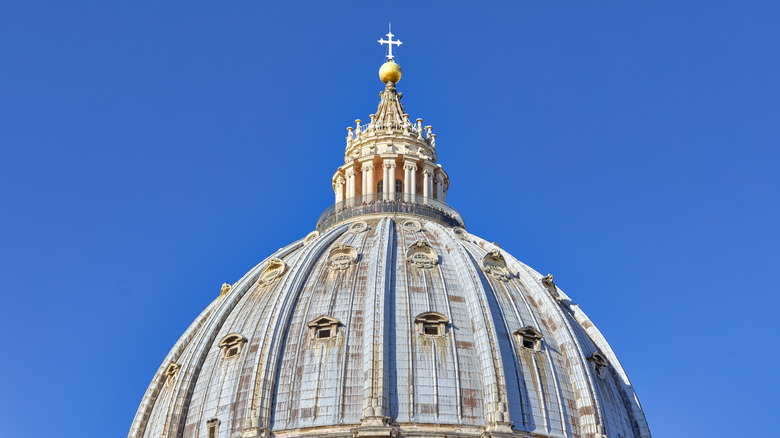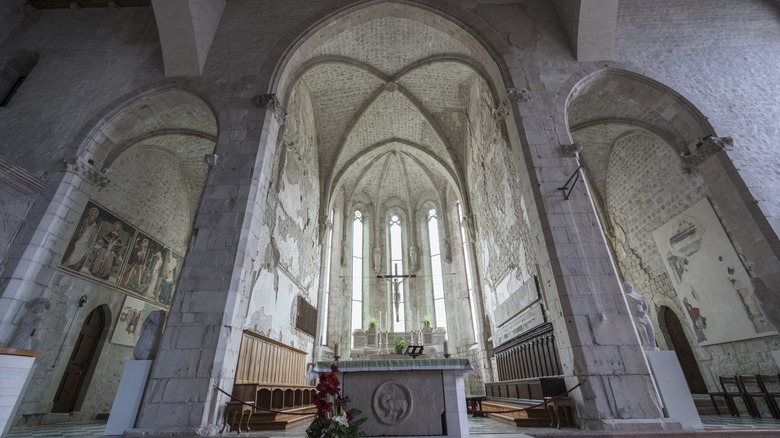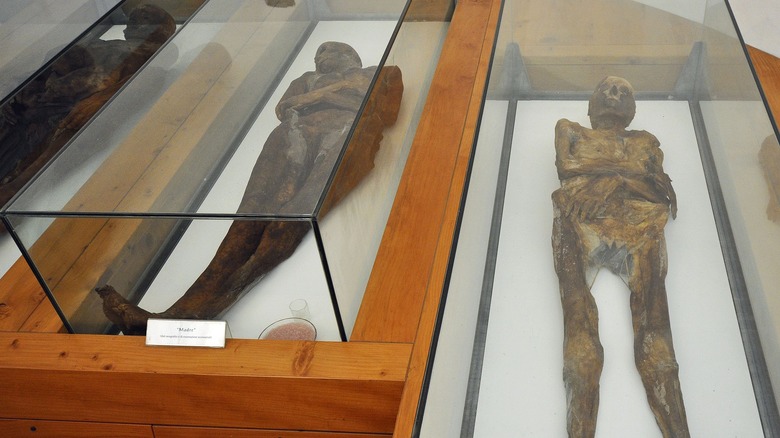Mummified Bodies Uncovered In 17th-Century Italy Still Puzzle Scientists
It's not too often that people stumble across the fleshless and desiccated remains of the once-living. That is, unless you happen to be a policeman in Peru peering into a red food delivery bag. Or, if you happen to be a Dane tripping over a bog body like Tollund Man in a foggy marsh. Or if you happened to be of the sect of Shugendo Buddhist monks in Japan who self-mummified while alive. Or if you happen to be an archaeologist who recently discovered a gold-leaf-covered mummy south of Cairo, Egypt, per the BBC. Or if ... you know what, never mind. Trust us when we say that mummies are not too common — that's why their appearances make the news.
But if you happened to be traipsing about the tiny town of Venzone, Italy in the country's northeast Alps circa 1647 or so, you might have spotted a mummy propped against a wall like a mannequin, and then another in the queue being passed along by laborers who found them while doing construction on a cathedral. And then another, and another, and another — about 40, in fact, as The Vintage News continues. Fifteen of these mummies still survive to the present and continue to defy explanation. By all accounts, the mummification was accidental and possibly the result of some fungus growing in the crypt where the mummies were found. Let's just be glad the workers who discovered them didn't crack open a crypt of ravenous, swarming fungus zombies.
300-year-old local guardians
It doesn't take more than a glance at the mummies of Venzone to notice that their skin is thin and papery, almost like parchment or papyrus. Not that mummies are well-hydrated, but the skin of the mummies of Venzone helps explain the natural mummification process. Atlas Obscura describes the fungus in the tomb where the mummies were found — in the former Chapel of San Michele (Saint Michael) — as a type of parasitic mold called "Hipha Bombicina Pers" that quickly dehydrates flesh and slows decomposition. The Vintage News points out that not enough of the fungus was found in the tomb to fully account for the mummification, saying that the limestone floor likely played a role, as well. But still, the precise mummification process remains a mystery.
The mummies weren't found all at one time. The first one to be found in 1647 was dubbed "Gobbo" — Italian for hunchback — because of its posture. Locals apparently thought the mummies were gifts from God meant to protect Venzone, as Weird Italy says. They remained locally known for about 300 years until Jack Birns, an American photographer in the 1950s, roamed into the village at night looking for a room and promptly stumbled across an elderly man drinking tea with his mummy buddy. Birns brokered some kind of photo op deal, and the world got its first glimpse of the mummies in Life Magazine, propped up for poses in the hands of locals.
Relocated after an earthquake
Researchers and the morbidly curious didn't have much time to examine the mummies of Venzone after Jack Birns took his "hanging out with the dead" photo op in the 1950s. In true — but slightly delayed — mummy's curse fashion, an earthquake blasted the region of Venzone in 1976, as Venzone Tourismo explains. The town got wrecked, and as soon as the mummies were fished out of the rubble — less 25 or so — they got moved to from the chapel of San Michele to a nearby crypt in the chapel's cemetery. That cemetery, where they currently reside, is located in the churchyard of the Cathedral of St. Andrew the Apostle. Five of the mummies are on display behind glass and open for visitation — provided tourists and travelers can make the journey.
Visitors would be mistaken to think that the mummies all date back to the same era, however. It's not the case that 40 or so bodies were entombed at the same time and all got mummified together. As Venzone Tourismo says, the practice was going on for quite some time — the oldest mummy dates back to 1348, and the newest 1881. Whether those responsible for burying the dead recognized that bodies were undergoing mummification and then tried to replicate the process is unknown. But regardless, each individual is mummified in the first year after death. Eventually, a separate chapel -— the Chapel of the Rosary — was built over the spot of their original discovery.


